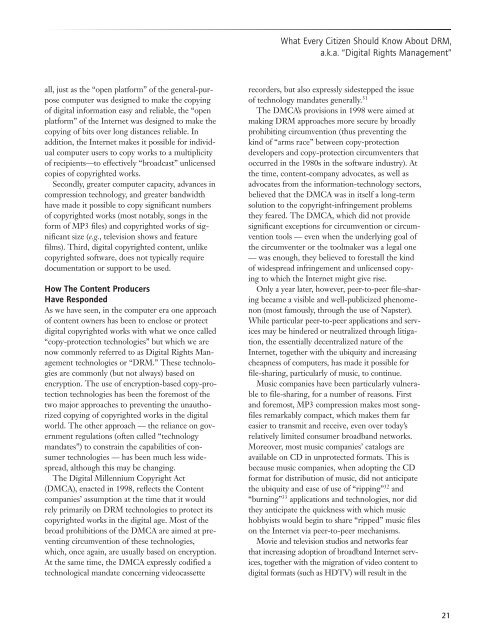What Every Citizen Should Know About DRM, aka - Public Knowledge
What Every Citizen Should Know About DRM, aka - Public Knowledge
What Every Citizen Should Know About DRM, aka - Public Knowledge
You also want an ePaper? Increase the reach of your titles
YUMPU automatically turns print PDFs into web optimized ePapers that Google loves.
<strong>What</strong> <strong>Every</strong> <strong>Citizen</strong> <strong>Should</strong> <strong>Know</strong> <strong>About</strong> <strong>DRM</strong>,a.k.a. “Digital Rights Management”all, just as the “open platform” of the general-purposecomputer was designed to make the copyingof digital information easy and reliable, the “openplatform” of the Internet was designed to make thecopying of bits over long distances reliable. Inaddition, the Internet makes it possible for individualcomputer users to copy works to a multiplicityof recipients—to effectively “broadcast” unlicensedcopies of copyrighted works.Secondly, greater computer capacity, advances incompression technology, and greater bandwidthhave made it possible to copy significant numbersof copyrighted works (most notably, songs in theform of MP3 files) and copyrighted works of significantsize (e.g., television shows and featurefilms). Third, digital copyrighted content, unlikecopyrighted software, does not typically requiredocumentation or support to be used.How The Content ProducersHave RespondedAs we have seen, in the computer era one approachof content owners has been to enclose or protectdigital copyrighted works with what we once called“copy-protection technologies” but which we arenow commonly referred to as Digital Rights Managementtechnologies or “<strong>DRM</strong>.” These technologiesare commonly (but not always) based onencryption. The use of encryption-based copy-protectiontechnologies has been the foremost of thetwo major approaches to preventing the unauthorizedcopying of copyrighted works in the digitalworld. The other approach — the reliance on governmentregulations (often called “technologymandates”) to constrain the capabilities of consumertechnologies — has been much less widespread,although this may be changing.The Digital Millennium Copyright Act(DMCA), enacted in 1998, reflects the Contentcompanies’ assumption at the time that it wouldrely primarily on <strong>DRM</strong> technologies to protect itscopyrighted works in the digital age. Most of thebroad prohibitions of the DMCA are aimed at preventingcircumvention of these technologies,which, once again, are usually based on encryption.At the same time, the DMCA expressly codified atechnological mandate concerning videocassetterecorders, but also expressly sidestepped the issueof technology mandates generally. 31The DMCA’s provisions in 1998 were aimed atmaking <strong>DRM</strong> approaches more secure by broadlyprohibiting circumvention (thus preventing thekind of “arms race” between copy-protectiondevelopers and copy-protection circumventers thatoccurred in the 1980s in the software industry). Atthe time, content-company advocates, as well asadvocates from the information-technology sectors,believed that the DMCA was in itself a long-termsolution to the copyright-infringement problemsthey feared. The DMCA, which did not providesignificant exceptions for circumvention or circumventiontools — even when the underlying goal ofthe circumventer or the toolmaker was a legal one— was enough, they believed to forestall the kindof widespread infringement and unlicensed copyingto which the Internet might give rise.Only a year later, however, peer-to-peer file-sharingbecame a visible and well-publicized phenomenon(most famously, through the use of Napster).While particular peer-to-peer applications and servicesmay be hindered or neutralized through litigation,the essentially decentralized nature of theInternet, together with the ubiquity and increasingcheapness of computers, has made it possible forfile-sharing, particularly of music, to continue.Music companies have been particularly vulnerableto file-sharing, for a number of reasons. Firstand foremost, MP3 compression makes most songfilesremarkably compact, which makes them fareasier to transmit and receive, even over today’srelatively limited consumer broadband networks.Moreover, most music companies’ catalogs areavailable on CD in unprotected formats. This isbecause music companies, when adopting the CDformat for distribution of music, did not anticipatethe ubiquity and ease of use of “ripping” 32 and“burning” 33 applications and technologies, nor didthey anticipate the quickness with which musichobbyists would begin to share “ripped” music fileson the Internet via peer-to-peer mechanisms.Movie and television studios and networks fearthat increasing adoption of broadband Internet services,together with the migration of video content todigital formats (such as HDTV) will result in the21





